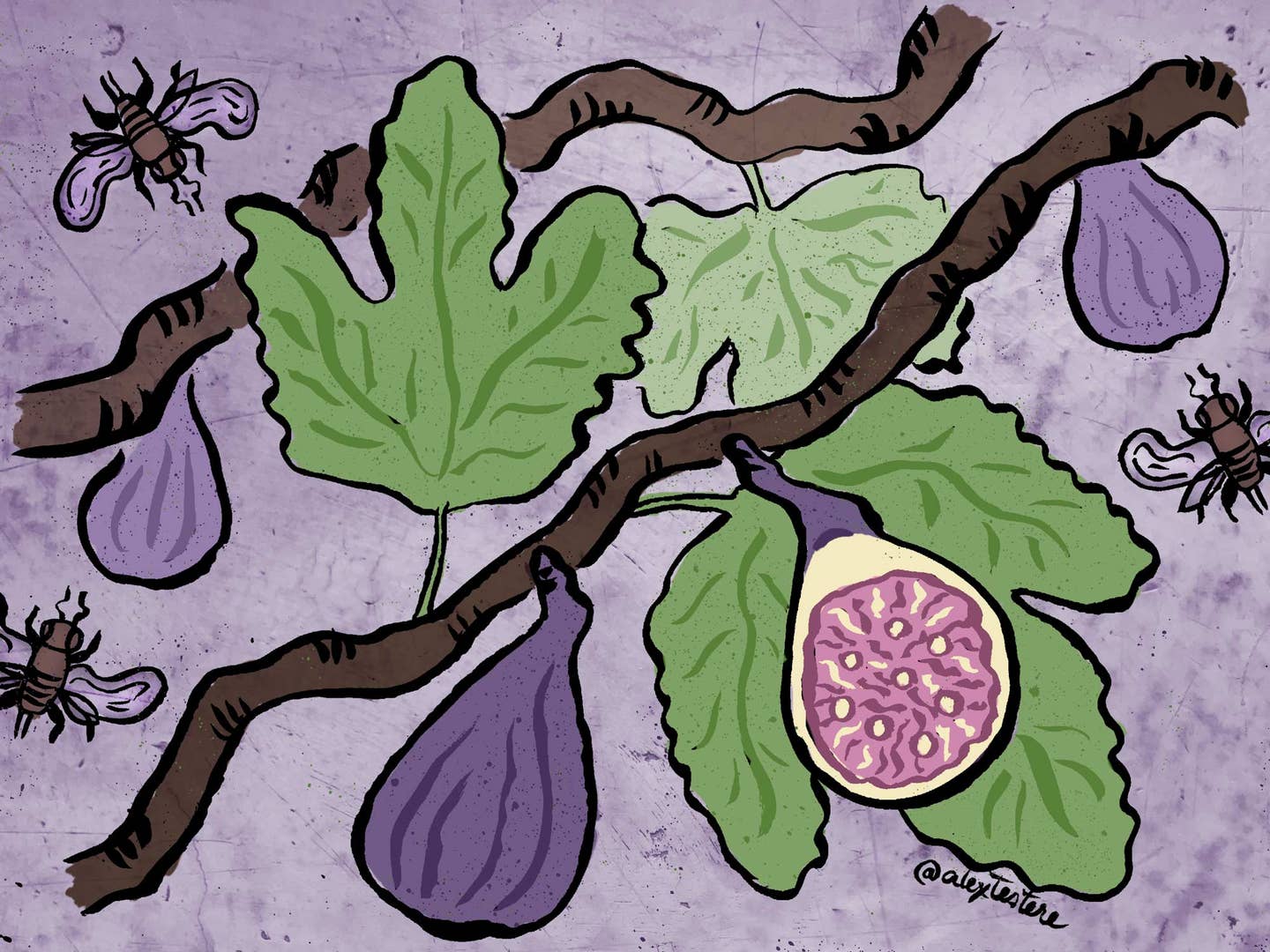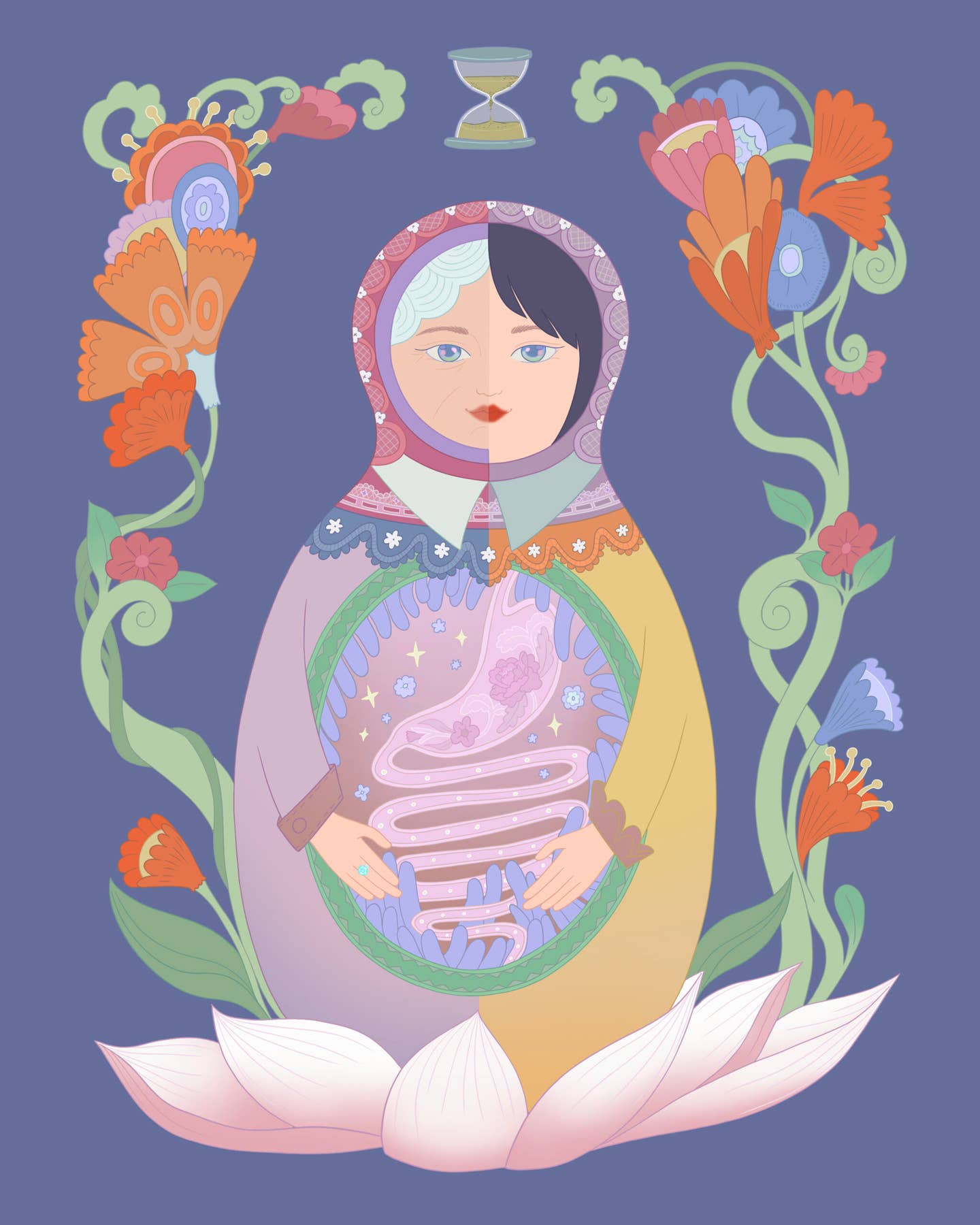
The Romantic, Tragic, and Profoundly Gross Evolutionary Tale of the Fig Tree
“It starts with sex and ends with violence,” and in between reveals a remarkably complex and ancient symbiosis between fruit and fruit wasps that shows just how weird nature can get
"It starts with sex and ends with violence," says author Mike Shanahan on the life cycle of the fig wasp, a tiny insect whose life begins and ends inside a fig. Shanahan's recent book, Gods, Wasps, and Stranglers, tackles the peculiar and primordial history of the fig tree, but the story can't be told without addressing the fig's unlikely evolutionary companion.
Eighty million years ago, it’s believed, for reasons beyond our humdrum human understanding, a flowering fig tree’s flashy blossoms turned quietly inward, sequestering themselves from the elements and guarding their precious reproductive pollen for one visitor alone.
It was an evolutionary commitment; bees, birds, bats, the wind, and any number of environmental factors would never again be able to assist with pollination. In one of nature's most enduring examples of codependence, a single wasp, smaller than two millimeters in length, became the fig's sole pollinator. In turn, that wasp, which lives for a mere two days in its mature state, feeds on figs and only figs as a larva before returning to the tree to lay its eggs.
Ever since, the fig tree and the fig wasp have been inextricably intertwined.
Symbiotic partnerships are common in nature. Cows, for example, house hordes of healthy bacteria in their intestines that help them to digest the cellulose in grass, while the bacteria gain a life-long supply of nutrients. The relationships between most plants and pollinators, in fact, are considered mutualistic; the plants provide nectar to various animals, and the animals, in turn, facilitate the spread of pollen for reproduction.
But fig trees and wasps are more than mutually benefitting partners. By eliminating all other sources of pollinators and egg-laying refuge respectively, the organisms have co-evolved, proliferating in near perfect symmetry: Both have produced some 800-odd species across the world, each (more or less) uniquely tied to one another.
It’s almost romantic to imagine such a relationship, two units growing and evolving together in domestic harmony. One species of tree and one species of wasp, searching for its match. But that’s about where the metaphor ends; the reality is more grim.
Here’s the simplified version: Since fig fruits are technically inverted clusters of flowers, all the psychedelic squiggly bits you see when you cut into one are the petals, and the crunchy bits are (not wasps, don’t worry), the seeds that have developed inside each flower. As it turns out, these flowers are the perfect nesting grounds for a particular diminutive group of wasps who can detect the alluring scent of a fig that’s primed for receiving eggs. The female wasp enters the fig through a pin-prick opening at its bottom, one so small that its wings and antennae are ripped from its body as it crawls through.
It only gets worse from here.
Unable to escape the fig, the flightless wasp then deposits its eggs into as many of the flowers as she can before it dies. As the eggs mature, the male wasps are born first, blind and also flightless, and they seek out the female larvae still developing among them and impregnate their siblings before they’ve even hatched. Having done their life’s one great work the moment they’re born, the males use their (relatively) massive jaws to bite exit tunnels out of the fig before either crawling back to the center to die, or sacrificing themselves to any predators who might be guarding the exit, lest they attack the females.
The females are, quite efficiently, born pregnant, and using the male wasps’ tunnels exit the fig and take to the skies, bringing a sample of the fig’s internal flower pollen with them. The tiny wasps, swept away by the wind, can travel tremendous distances in search of the next fertile fig tree of the correct species, where, before their two-day-long lives come to an end, they must crawl in through the bottom and begin the process again.
Considering there are hundreds of diverse species of both fig wasps and fig trees, the full story is more complicated: Some fig tree species have male and female trees (which mostly just confuses the wasps); some fig wasps are parasitic and don't carry pollen at all (which is a bummer for the fig trees), and some fig species have been bred to be parthenocarpic, which means they actually reproduce asexually, without any pollen transfer whatsoever.
The latter is the case for some of Ficus carica, the common California fig that makes up 90% of America's fig consumption. So you can rest easy that you aren't going to find any wasps in your supermarket figs, and even if you were to eat a wild, wasp-pollinated fig, enzymes released by the fig as it ripens essentially digest the carcasses of any wasps that might have died inside. "It's a bit of a myth," says Shanahan, "that there are dead wasps in your figs. There might be some animal DNA in there, but it'd be so fragmentary that you'd never notice it."
Such a unique, specialized co-adaptation goes to show that survival of the fittest happens in all kinds of ways. It’s also a testament to the critical importance of biodiversity in our ecosystems.
“What this relationship allows,” Shanahan tells me, “is that the fig trees can exist at a very low density. They’ve overcome the big challenges that flowering plants have. They don’t have to be present in large numbers; they can be sparsely distributed but still have a very high level of pollination.” Because they can exist in near isolation almost anywhere in the world, they have evolved into hundreds of unique species in different environmental niches. In tandem, they’ve mastered the art of adaptation.
The partnership also provides for more than just fig trees and wasps alone. In the tropical zones where most species of figs trees grow (and where they are most commonly pollinated by wasps), solitary trees can thrive anywhere, producing figs for more than 1,200 species of local wildlife. “Figs are produced year-round whereas most fruits are produced in a single season,” says Shanahan. “They’re always there, and so they become crucial to a huge variety of fruit-eating animals.”
Since a fig tree has ripening figs year-round, the pollination cycle never ends, and the unique circumstances of that pollination mean that there’s no need to rely on the cross-pollination that results from monoculture trees growing en masse. A single dropped fig seed has a very good chance of becoming a prolific food source. And since the figs keep the animals alive, which then go on to eat the fruits of other trees, they help ensure that all plant life thrives. “Take the figs away,” notes Shanahan, “and you risk losing the dispersal of all the plant species.”
Keep Reading
Continue to Next Story










